University Employment Law Assignment: Age Discrimination Analysis
VerifiedAdded on 2022/10/03
|8
|1896
|72
Essay
AI Summary
This essay delves into the complex issue of age discrimination in employment within the United States, examining its various facets and legal ramifications. It begins by defining age discrimination and highlighting its prohibition under federal laws, including the Fifth and Fourteenth Amendments of the U.S. Constitution, the Civil Rights Act of 1964, the Age Discrimination in Employment Act of 1967 (ADEA), and the Age Discrimination Act of 1975. The paper explores the underlying reasons for age discrimination, such as higher salaries of older employees, perceived lack of modern skills, and potential health concerns. It then provides a critical analysis of the issue, citing studies and statistics to support its arguments. Finally, it outlines the specific laws and regulations designed to protect individuals from age-related discrimination in the workplace, emphasizing the role of the Equal Employment Opportunity Commission (EEOC) in enforcing these protections. The essay concludes by emphasizing the need for older workers to emphasize their skills and training to remain competitive in the job market.
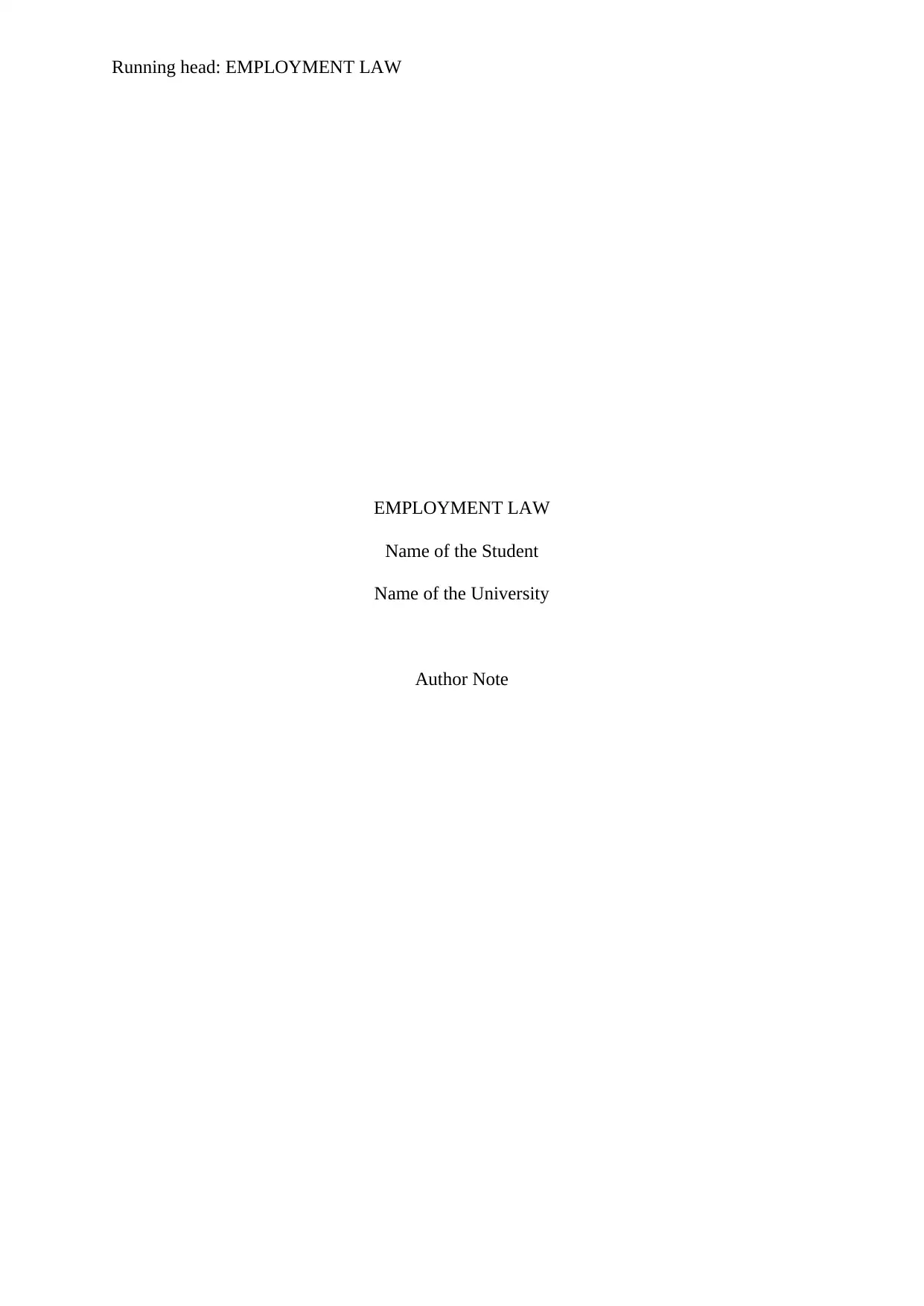
Running head: EMPLOYMENT LAW
EMPLOYMENT LAW
Name of the Student
Name of the University
Author Note
EMPLOYMENT LAW
Name of the Student
Name of the University
Author Note
Paraphrase This Document
Need a fresh take? Get an instant paraphrase of this document with our AI Paraphraser
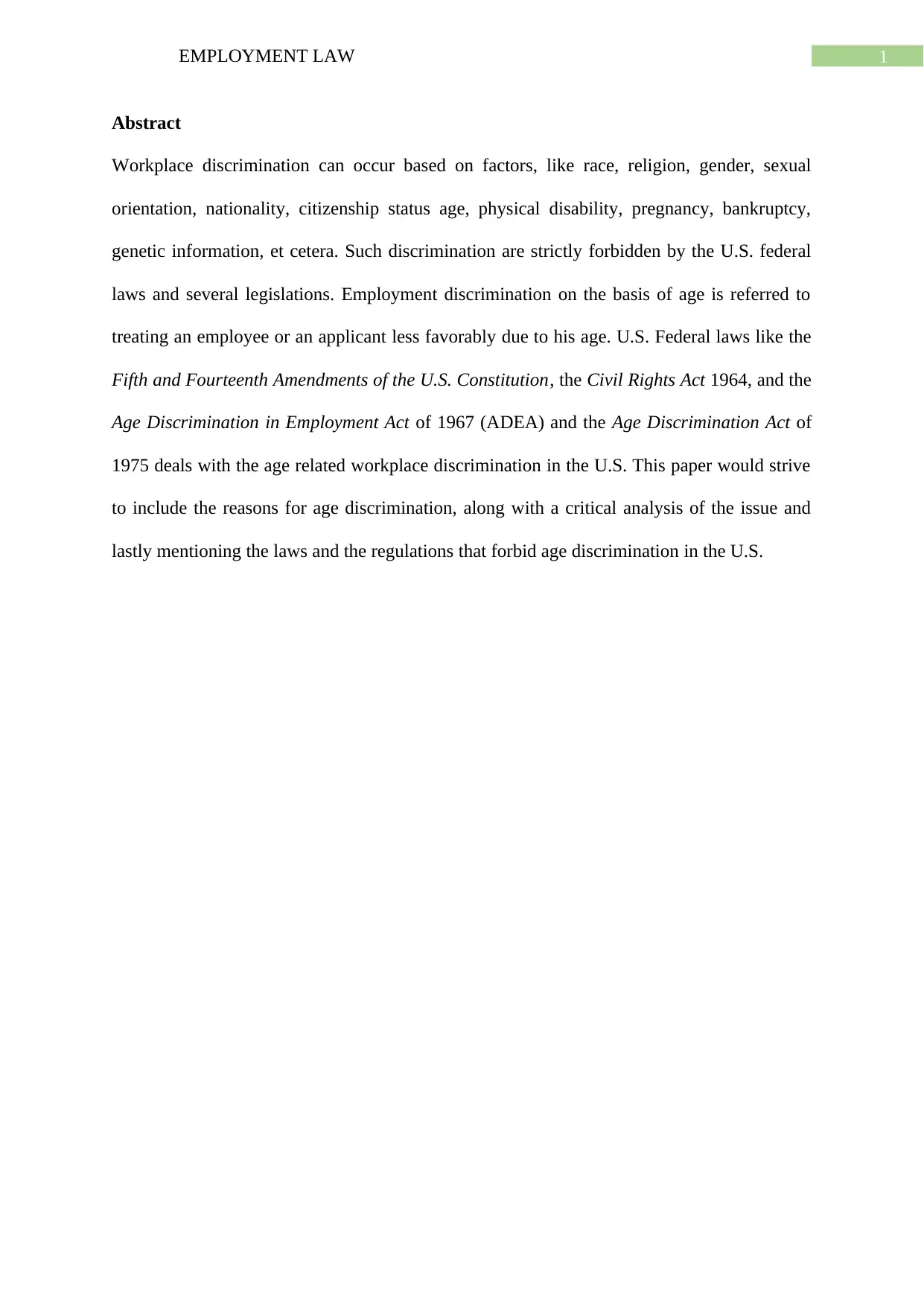
1EMPLOYMENT LAW
Abstract
Workplace discrimination can occur based on factors, like race, religion, gender, sexual
orientation, nationality, citizenship status age, physical disability, pregnancy, bankruptcy,
genetic information, et cetera. Such discrimination are strictly forbidden by the U.S. federal
laws and several legislations. Employment discrimination on the basis of age is referred to
treating an employee or an applicant less favorably due to his age. U.S. Federal laws like the
Fifth and Fourteenth Amendments of the U.S. Constitution, the Civil Rights Act 1964, and the
Age Discrimination in Employment Act of 1967 (ADEA) and the Age Discrimination Act of
1975 deals with the age related workplace discrimination in the U.S. This paper would strive
to include the reasons for age discrimination, along with a critical analysis of the issue and
lastly mentioning the laws and the regulations that forbid age discrimination in the U.S.
Abstract
Workplace discrimination can occur based on factors, like race, religion, gender, sexual
orientation, nationality, citizenship status age, physical disability, pregnancy, bankruptcy,
genetic information, et cetera. Such discrimination are strictly forbidden by the U.S. federal
laws and several legislations. Employment discrimination on the basis of age is referred to
treating an employee or an applicant less favorably due to his age. U.S. Federal laws like the
Fifth and Fourteenth Amendments of the U.S. Constitution, the Civil Rights Act 1964, and the
Age Discrimination in Employment Act of 1967 (ADEA) and the Age Discrimination Act of
1975 deals with the age related workplace discrimination in the U.S. This paper would strive
to include the reasons for age discrimination, along with a critical analysis of the issue and
lastly mentioning the laws and the regulations that forbid age discrimination in the U.S.
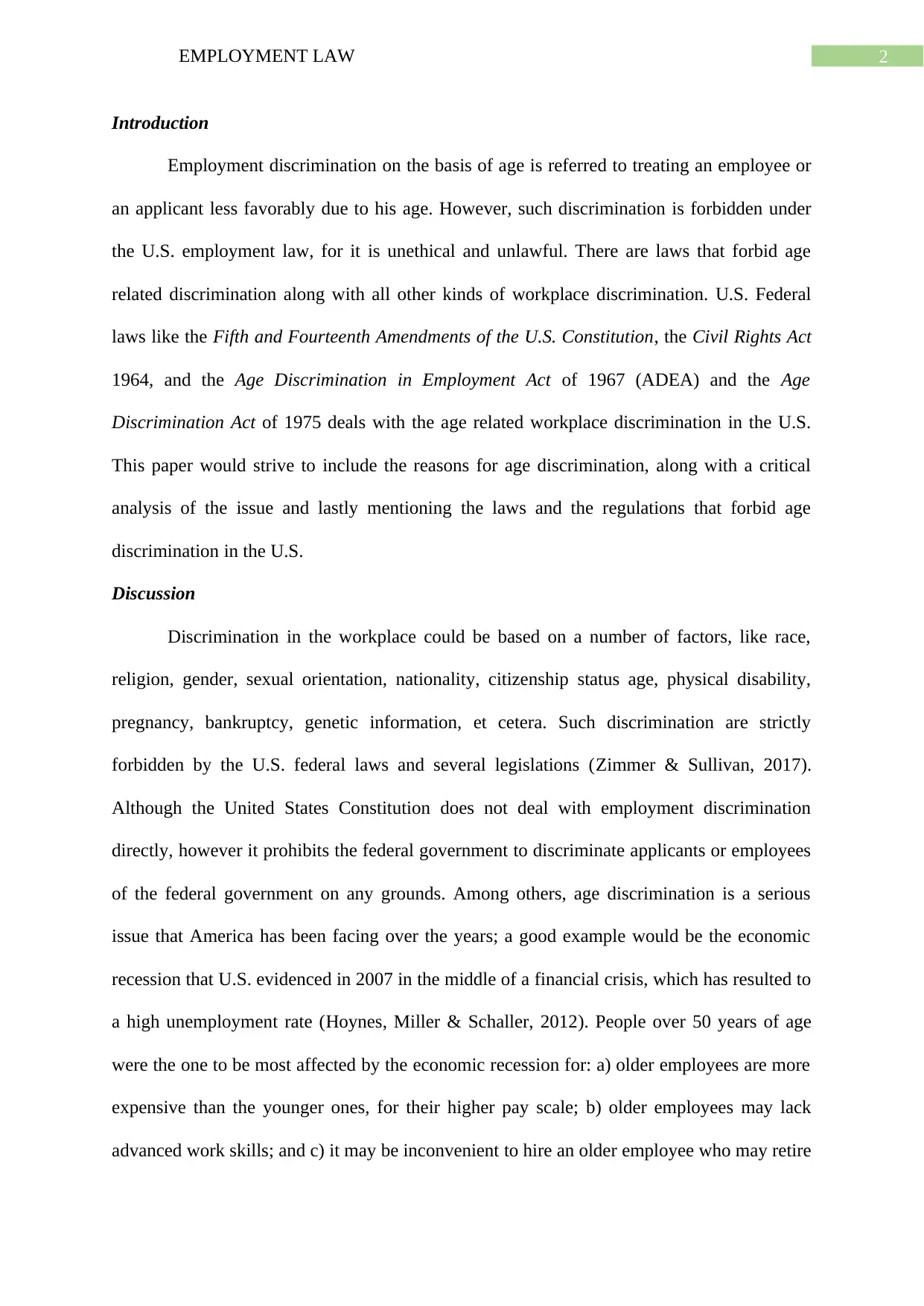
2EMPLOYMENT LAW
Introduction
Employment discrimination on the basis of age is referred to treating an employee or
an applicant less favorably due to his age. However, such discrimination is forbidden under
the U.S. employment law, for it is unethical and unlawful. There are laws that forbid age
related discrimination along with all other kinds of workplace discrimination. U.S. Federal
laws like the Fifth and Fourteenth Amendments of the U.S. Constitution, the Civil Rights Act
1964, and the Age Discrimination in Employment Act of 1967 (ADEA) and the Age
Discrimination Act of 1975 deals with the age related workplace discrimination in the U.S.
This paper would strive to include the reasons for age discrimination, along with a critical
analysis of the issue and lastly mentioning the laws and the regulations that forbid age
discrimination in the U.S.
Discussion
Discrimination in the workplace could be based on a number of factors, like race,
religion, gender, sexual orientation, nationality, citizenship status age, physical disability,
pregnancy, bankruptcy, genetic information, et cetera. Such discrimination are strictly
forbidden by the U.S. federal laws and several legislations (Zimmer & Sullivan, 2017).
Although the United States Constitution does not deal with employment discrimination
directly, however it prohibits the federal government to discriminate applicants or employees
of the federal government on any grounds. Among others, age discrimination is a serious
issue that America has been facing over the years; a good example would be the economic
recession that U.S. evidenced in 2007 in the middle of a financial crisis, which has resulted to
a high unemployment rate (Hoynes, Miller & Schaller, 2012). People over 50 years of age
were the one to be most affected by the economic recession for: a) older employees are more
expensive than the younger ones, for their higher pay scale; b) older employees may lack
advanced work skills; and c) it may be inconvenient to hire an older employee who may retire
Introduction
Employment discrimination on the basis of age is referred to treating an employee or
an applicant less favorably due to his age. However, such discrimination is forbidden under
the U.S. employment law, for it is unethical and unlawful. There are laws that forbid age
related discrimination along with all other kinds of workplace discrimination. U.S. Federal
laws like the Fifth and Fourteenth Amendments of the U.S. Constitution, the Civil Rights Act
1964, and the Age Discrimination in Employment Act of 1967 (ADEA) and the Age
Discrimination Act of 1975 deals with the age related workplace discrimination in the U.S.
This paper would strive to include the reasons for age discrimination, along with a critical
analysis of the issue and lastly mentioning the laws and the regulations that forbid age
discrimination in the U.S.
Discussion
Discrimination in the workplace could be based on a number of factors, like race,
religion, gender, sexual orientation, nationality, citizenship status age, physical disability,
pregnancy, bankruptcy, genetic information, et cetera. Such discrimination are strictly
forbidden by the U.S. federal laws and several legislations (Zimmer & Sullivan, 2017).
Although the United States Constitution does not deal with employment discrimination
directly, however it prohibits the federal government to discriminate applicants or employees
of the federal government on any grounds. Among others, age discrimination is a serious
issue that America has been facing over the years; a good example would be the economic
recession that U.S. evidenced in 2007 in the middle of a financial crisis, which has resulted to
a high unemployment rate (Hoynes, Miller & Schaller, 2012). People over 50 years of age
were the one to be most affected by the economic recession for: a) older employees are more
expensive than the younger ones, for their higher pay scale; b) older employees may lack
advanced work skills; and c) it may be inconvenient to hire an older employee who may retire
⊘ This is a preview!⊘
Do you want full access?
Subscribe today to unlock all pages.

Trusted by 1+ million students worldwide
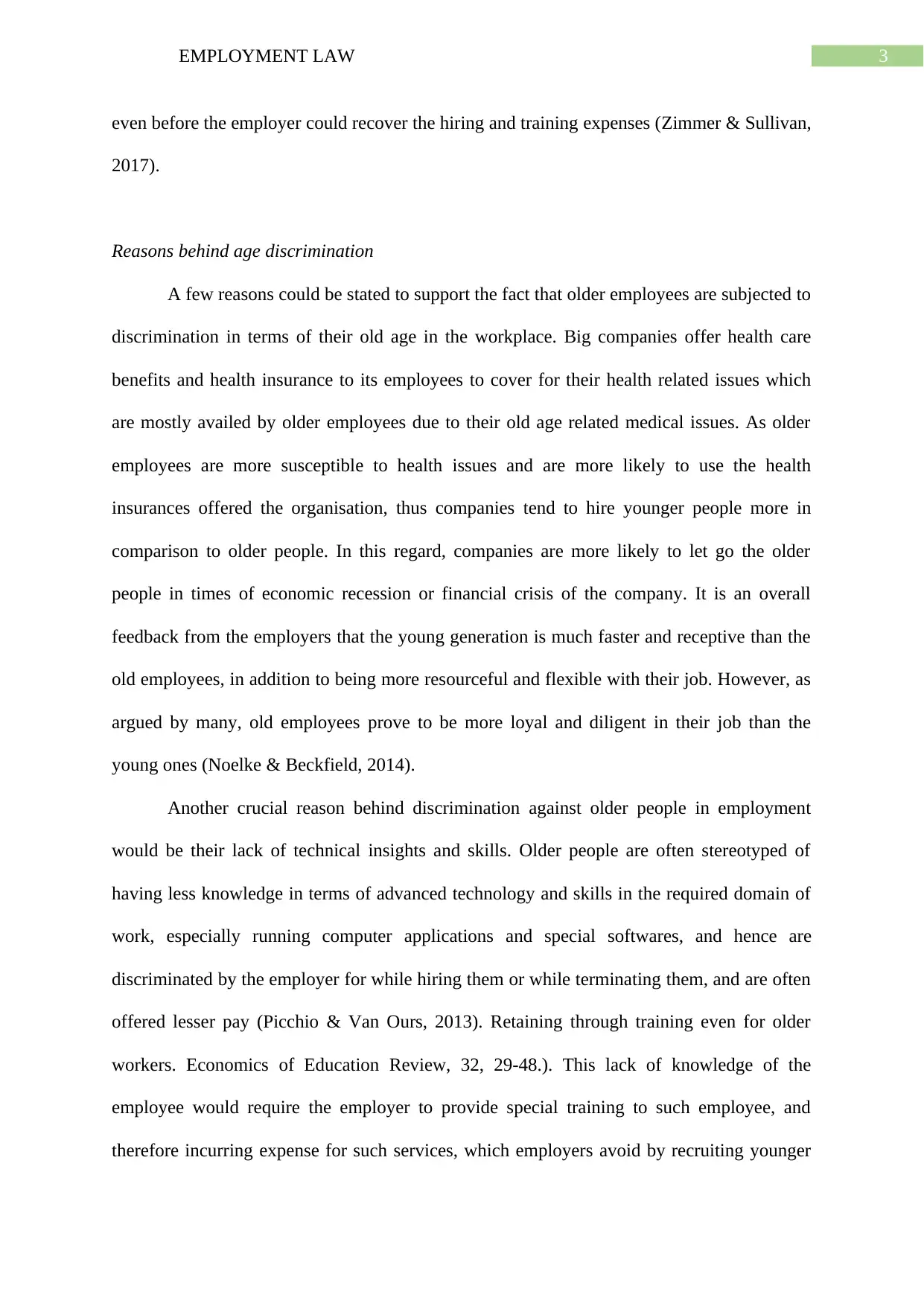
3EMPLOYMENT LAW
even before the employer could recover the hiring and training expenses (Zimmer & Sullivan,
2017).
Reasons behind age discrimination
A few reasons could be stated to support the fact that older employees are subjected to
discrimination in terms of their old age in the workplace. Big companies offer health care
benefits and health insurance to its employees to cover for their health related issues which
are mostly availed by older employees due to their old age related medical issues. As older
employees are more susceptible to health issues and are more likely to use the health
insurances offered the organisation, thus companies tend to hire younger people more in
comparison to older people. In this regard, companies are more likely to let go the older
people in times of economic recession or financial crisis of the company. It is an overall
feedback from the employers that the young generation is much faster and receptive than the
old employees, in addition to being more resourceful and flexible with their job. However, as
argued by many, old employees prove to be more loyal and diligent in their job than the
young ones (Noelke & Beckfield, 2014).
Another crucial reason behind discrimination against older people in employment
would be their lack of technical insights and skills. Older people are often stereotyped of
having less knowledge in terms of advanced technology and skills in the required domain of
work, especially running computer applications and special softwares, and hence are
discriminated by the employer for while hiring them or while terminating them, and are often
offered lesser pay (Picchio & Van Ours, 2013). Retaining through training even for older
workers. Economics of Education Review, 32, 29-48.). This lack of knowledge of the
employee would require the employer to provide special training to such employee, and
therefore incurring expense for such services, which employers avoid by recruiting younger
even before the employer could recover the hiring and training expenses (Zimmer & Sullivan,
2017).
Reasons behind age discrimination
A few reasons could be stated to support the fact that older employees are subjected to
discrimination in terms of their old age in the workplace. Big companies offer health care
benefits and health insurance to its employees to cover for their health related issues which
are mostly availed by older employees due to their old age related medical issues. As older
employees are more susceptible to health issues and are more likely to use the health
insurances offered the organisation, thus companies tend to hire younger people more in
comparison to older people. In this regard, companies are more likely to let go the older
people in times of economic recession or financial crisis of the company. It is an overall
feedback from the employers that the young generation is much faster and receptive than the
old employees, in addition to being more resourceful and flexible with their job. However, as
argued by many, old employees prove to be more loyal and diligent in their job than the
young ones (Noelke & Beckfield, 2014).
Another crucial reason behind discrimination against older people in employment
would be their lack of technical insights and skills. Older people are often stereotyped of
having less knowledge in terms of advanced technology and skills in the required domain of
work, especially running computer applications and special softwares, and hence are
discriminated by the employer for while hiring them or while terminating them, and are often
offered lesser pay (Picchio & Van Ours, 2013). Retaining through training even for older
workers. Economics of Education Review, 32, 29-48.). This lack of knowledge of the
employee would require the employer to provide special training to such employee, and
therefore incurring expense for such services, which employers avoid by recruiting younger
Paraphrase This Document
Need a fresh take? Get an instant paraphrase of this document with our AI Paraphraser
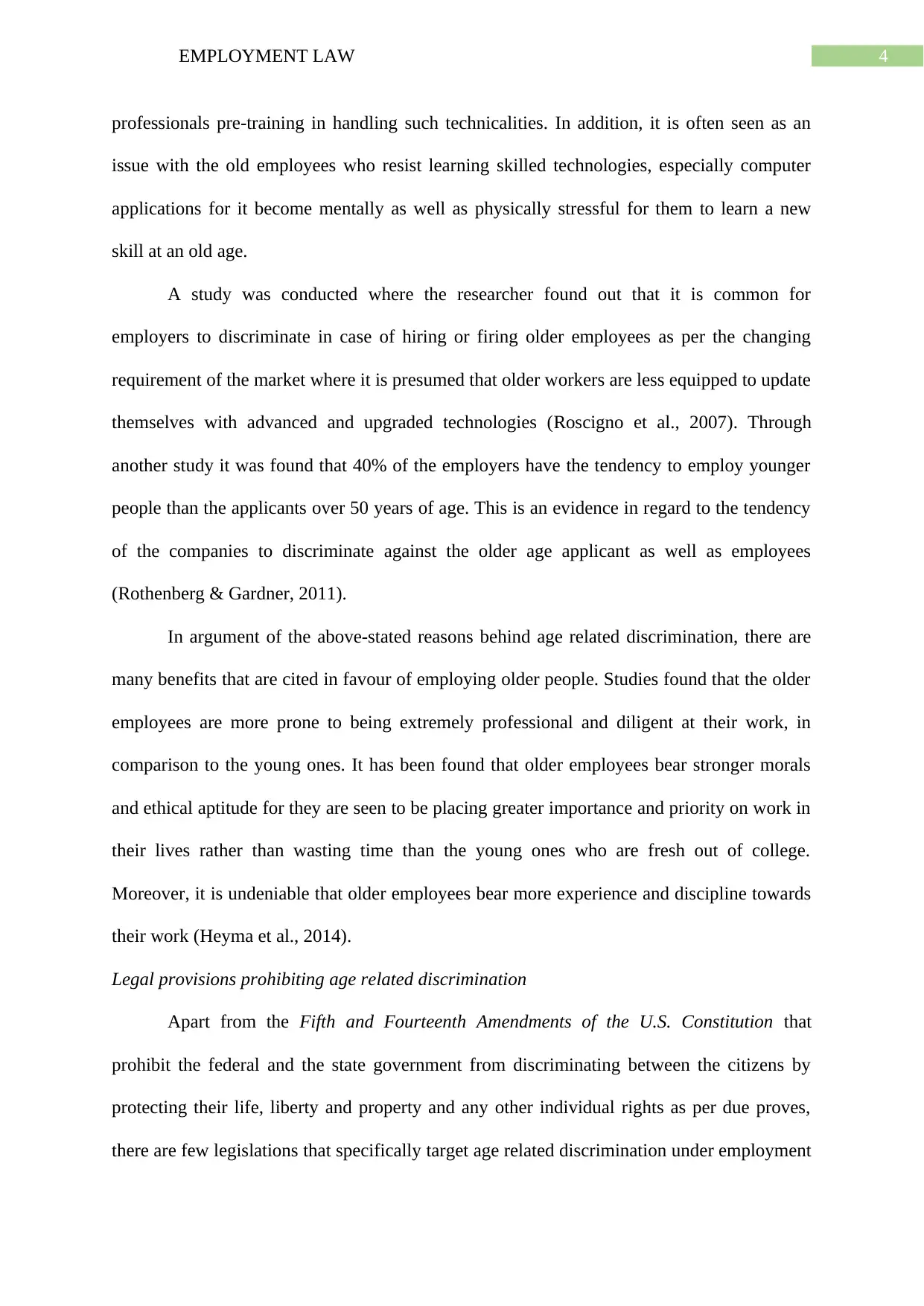
4EMPLOYMENT LAW
professionals pre-training in handling such technicalities. In addition, it is often seen as an
issue with the old employees who resist learning skilled technologies, especially computer
applications for it become mentally as well as physically stressful for them to learn a new
skill at an old age.
A study was conducted where the researcher found out that it is common for
employers to discriminate in case of hiring or firing older employees as per the changing
requirement of the market where it is presumed that older workers are less equipped to update
themselves with advanced and upgraded technologies (Roscigno et al., 2007). Through
another study it was found that 40% of the employers have the tendency to employ younger
people than the applicants over 50 years of age. This is an evidence in regard to the tendency
of the companies to discriminate against the older age applicant as well as employees
(Rothenberg & Gardner, 2011).
In argument of the above-stated reasons behind age related discrimination, there are
many benefits that are cited in favour of employing older people. Studies found that the older
employees are more prone to being extremely professional and diligent at their work, in
comparison to the young ones. It has been found that older employees bear stronger morals
and ethical aptitude for they are seen to be placing greater importance and priority on work in
their lives rather than wasting time than the young ones who are fresh out of college.
Moreover, it is undeniable that older employees bear more experience and discipline towards
their work (Heyma et al., 2014).
Legal provisions prohibiting age related discrimination
Apart from the Fifth and Fourteenth Amendments of the U.S. Constitution that
prohibit the federal and the state government from discriminating between the citizens by
protecting their life, liberty and property and any other individual rights as per due proves,
there are few legislations that specifically target age related discrimination under employment
professionals pre-training in handling such technicalities. In addition, it is often seen as an
issue with the old employees who resist learning skilled technologies, especially computer
applications for it become mentally as well as physically stressful for them to learn a new
skill at an old age.
A study was conducted where the researcher found out that it is common for
employers to discriminate in case of hiring or firing older employees as per the changing
requirement of the market where it is presumed that older workers are less equipped to update
themselves with advanced and upgraded technologies (Roscigno et al., 2007). Through
another study it was found that 40% of the employers have the tendency to employ younger
people than the applicants over 50 years of age. This is an evidence in regard to the tendency
of the companies to discriminate against the older age applicant as well as employees
(Rothenberg & Gardner, 2011).
In argument of the above-stated reasons behind age related discrimination, there are
many benefits that are cited in favour of employing older people. Studies found that the older
employees are more prone to being extremely professional and diligent at their work, in
comparison to the young ones. It has been found that older employees bear stronger morals
and ethical aptitude for they are seen to be placing greater importance and priority on work in
their lives rather than wasting time than the young ones who are fresh out of college.
Moreover, it is undeniable that older employees bear more experience and discipline towards
their work (Heyma et al., 2014).
Legal provisions prohibiting age related discrimination
Apart from the Fifth and Fourteenth Amendments of the U.S. Constitution that
prohibit the federal and the state government from discriminating between the citizens by
protecting their life, liberty and property and any other individual rights as per due proves,
there are few legislations that specifically target age related discrimination under employment
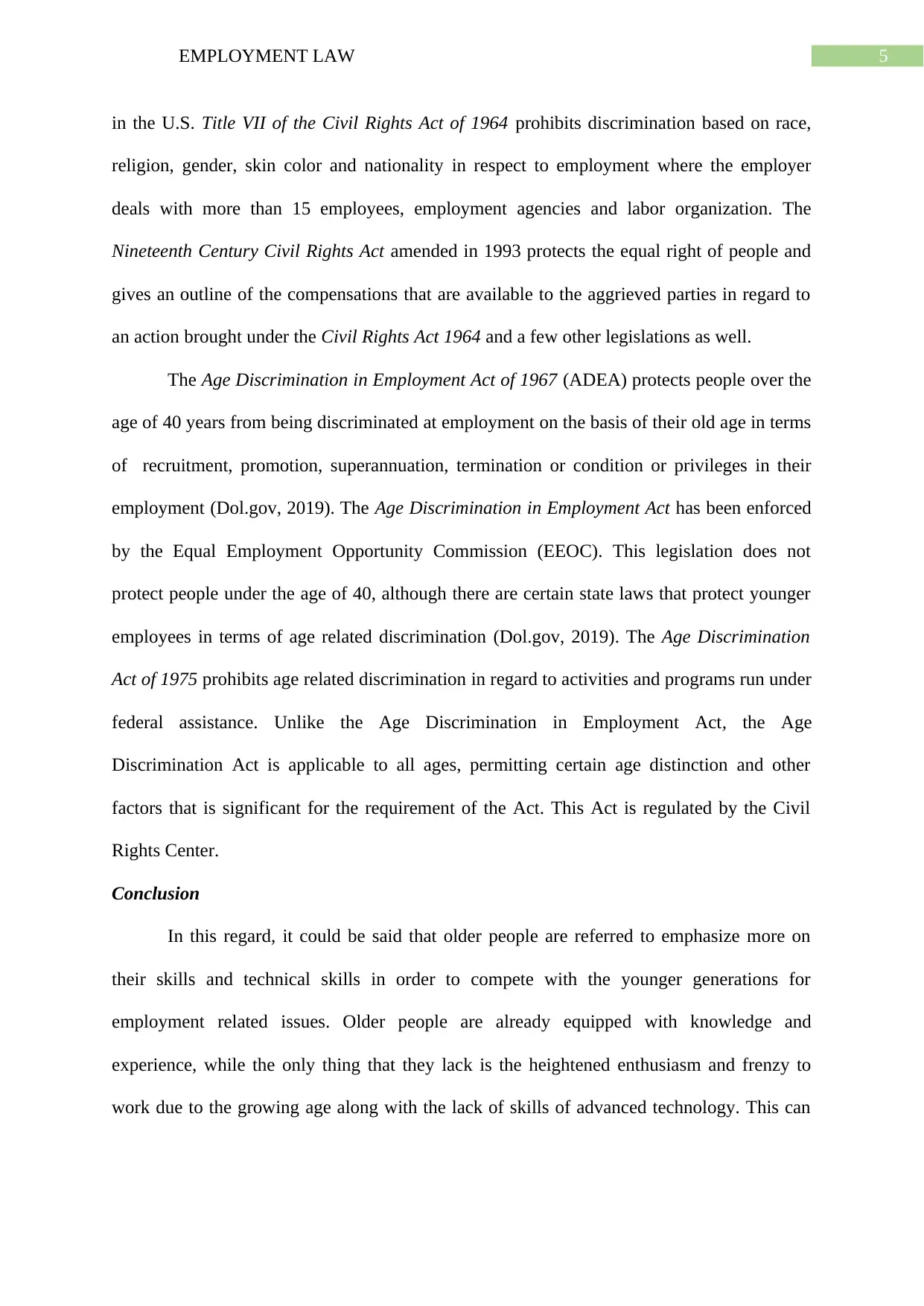
5EMPLOYMENT LAW
in the U.S. Title VII of the Civil Rights Act of 1964 prohibits discrimination based on race,
religion, gender, skin color and nationality in respect to employment where the employer
deals with more than 15 employees, employment agencies and labor organization. The
Nineteenth Century Civil Rights Act amended in 1993 protects the equal right of people and
gives an outline of the compensations that are available to the aggrieved parties in regard to
an action brought under the Civil Rights Act 1964 and a few other legislations as well.
The Age Discrimination in Employment Act of 1967 (ADEA) protects people over the
age of 40 years from being discriminated at employment on the basis of their old age in terms
of recruitment, promotion, superannuation, termination or condition or privileges in their
employment (Dol.gov, 2019). The Age Discrimination in Employment Act has been enforced
by the Equal Employment Opportunity Commission (EEOC). This legislation does not
protect people under the age of 40, although there are certain state laws that protect younger
employees in terms of age related discrimination (Dol.gov, 2019). The Age Discrimination
Act of 1975 prohibits age related discrimination in regard to activities and programs run under
federal assistance. Unlike the Age Discrimination in Employment Act, the Age
Discrimination Act is applicable to all ages, permitting certain age distinction and other
factors that is significant for the requirement of the Act. This Act is regulated by the Civil
Rights Center.
Conclusion
In this regard, it could be said that older people are referred to emphasize more on
their skills and technical skills in order to compete with the younger generations for
employment related issues. Older people are already equipped with knowledge and
experience, while the only thing that they lack is the heightened enthusiasm and frenzy to
work due to the growing age along with the lack of skills of advanced technology. This can
in the U.S. Title VII of the Civil Rights Act of 1964 prohibits discrimination based on race,
religion, gender, skin color and nationality in respect to employment where the employer
deals with more than 15 employees, employment agencies and labor organization. The
Nineteenth Century Civil Rights Act amended in 1993 protects the equal right of people and
gives an outline of the compensations that are available to the aggrieved parties in regard to
an action brought under the Civil Rights Act 1964 and a few other legislations as well.
The Age Discrimination in Employment Act of 1967 (ADEA) protects people over the
age of 40 years from being discriminated at employment on the basis of their old age in terms
of recruitment, promotion, superannuation, termination or condition or privileges in their
employment (Dol.gov, 2019). The Age Discrimination in Employment Act has been enforced
by the Equal Employment Opportunity Commission (EEOC). This legislation does not
protect people under the age of 40, although there are certain state laws that protect younger
employees in terms of age related discrimination (Dol.gov, 2019). The Age Discrimination
Act of 1975 prohibits age related discrimination in regard to activities and programs run under
federal assistance. Unlike the Age Discrimination in Employment Act, the Age
Discrimination Act is applicable to all ages, permitting certain age distinction and other
factors that is significant for the requirement of the Act. This Act is regulated by the Civil
Rights Center.
Conclusion
In this regard, it could be said that older people are referred to emphasize more on
their skills and technical skills in order to compete with the younger generations for
employment related issues. Older people are already equipped with knowledge and
experience, while the only thing that they lack is the heightened enthusiasm and frenzy to
work due to the growing age along with the lack of skills of advanced technology. This can
⊘ This is a preview!⊘
Do you want full access?
Subscribe today to unlock all pages.

Trusted by 1+ million students worldwide

6EMPLOYMENT LAW
be improved with training and vocational learning. In addition, the legislations tries their best
to give ample protection in case of age related discrimination in the U.S.
be improved with training and vocational learning. In addition, the legislations tries their best
to give ample protection in case of age related discrimination in the U.S.
Paraphrase This Document
Need a fresh take? Get an instant paraphrase of this document with our AI Paraphraser
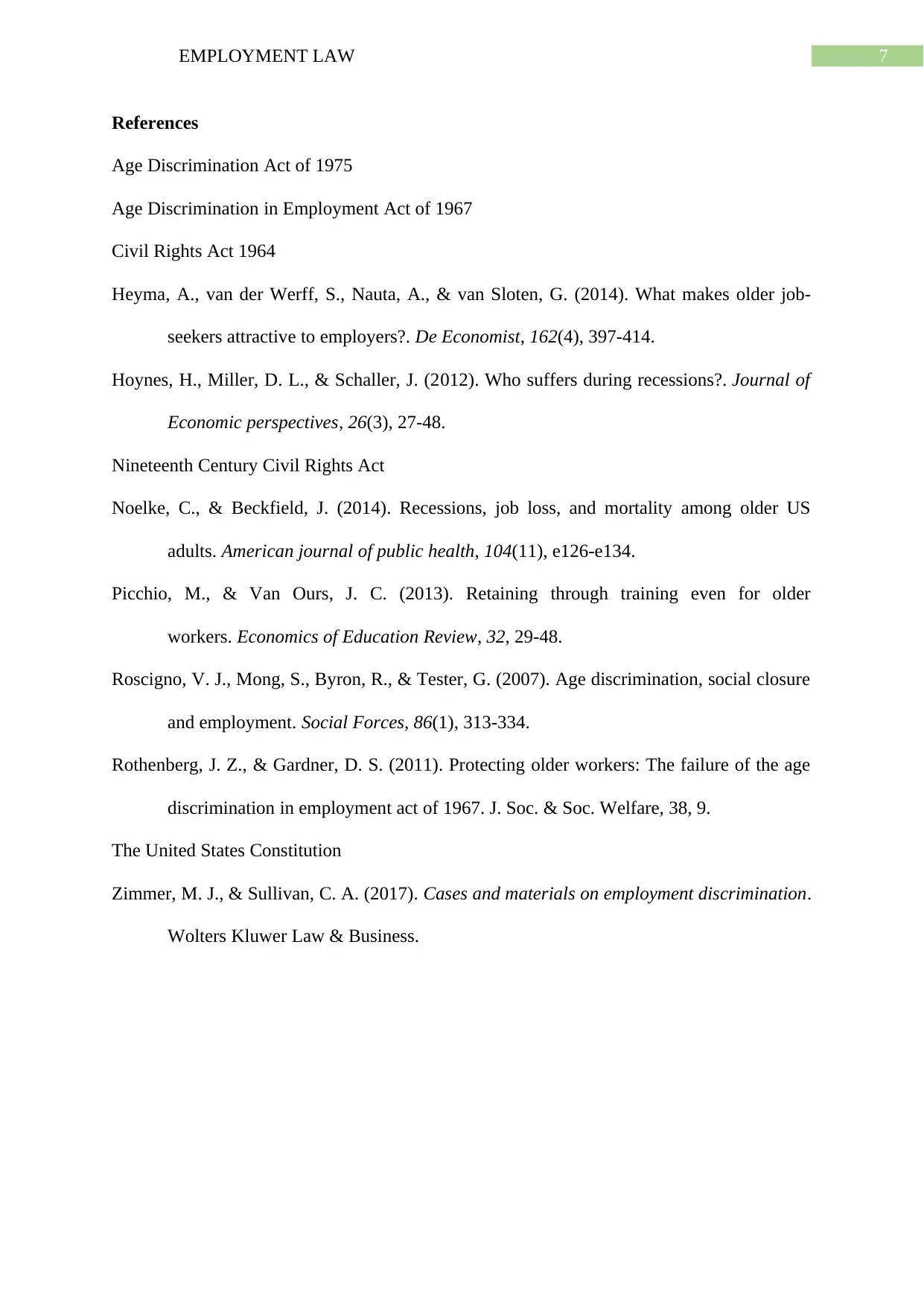
7EMPLOYMENT LAW
References
Age Discrimination Act of 1975
Age Discrimination in Employment Act of 1967
Civil Rights Act 1964
Heyma, A., van der Werff, S., Nauta, A., & van Sloten, G. (2014). What makes older job-
seekers attractive to employers?. De Economist, 162(4), 397-414.
Hoynes, H., Miller, D. L., & Schaller, J. (2012). Who suffers during recessions?. Journal of
Economic perspectives, 26(3), 27-48.
Nineteenth Century Civil Rights Act
Noelke, C., & Beckfield, J. (2014). Recessions, job loss, and mortality among older US
adults. American journal of public health, 104(11), e126-e134.
Picchio, M., & Van Ours, J. C. (2013). Retaining through training even for older
workers. Economics of Education Review, 32, 29-48.
Roscigno, V. J., Mong, S., Byron, R., & Tester, G. (2007). Age discrimination, social closure
and employment. Social Forces, 86(1), 313-334.
Rothenberg, J. Z., & Gardner, D. S. (2011). Protecting older workers: The failure of the age
discrimination in employment act of 1967. J. Soc. & Soc. Welfare, 38, 9.
The United States Constitution
Zimmer, M. J., & Sullivan, C. A. (2017). Cases and materials on employment discrimination.
Wolters Kluwer Law & Business.
References
Age Discrimination Act of 1975
Age Discrimination in Employment Act of 1967
Civil Rights Act 1964
Heyma, A., van der Werff, S., Nauta, A., & van Sloten, G. (2014). What makes older job-
seekers attractive to employers?. De Economist, 162(4), 397-414.
Hoynes, H., Miller, D. L., & Schaller, J. (2012). Who suffers during recessions?. Journal of
Economic perspectives, 26(3), 27-48.
Nineteenth Century Civil Rights Act
Noelke, C., & Beckfield, J. (2014). Recessions, job loss, and mortality among older US
adults. American journal of public health, 104(11), e126-e134.
Picchio, M., & Van Ours, J. C. (2013). Retaining through training even for older
workers. Economics of Education Review, 32, 29-48.
Roscigno, V. J., Mong, S., Byron, R., & Tester, G. (2007). Age discrimination, social closure
and employment. Social Forces, 86(1), 313-334.
Rothenberg, J. Z., & Gardner, D. S. (2011). Protecting older workers: The failure of the age
discrimination in employment act of 1967. J. Soc. & Soc. Welfare, 38, 9.
The United States Constitution
Zimmer, M. J., & Sullivan, C. A. (2017). Cases and materials on employment discrimination.
Wolters Kluwer Law & Business.
1 out of 8
Related Documents
Your All-in-One AI-Powered Toolkit for Academic Success.
+13062052269
info@desklib.com
Available 24*7 on WhatsApp / Email
![[object Object]](/_next/static/media/star-bottom.7253800d.svg)
Unlock your academic potential
Copyright © 2020–2025 A2Z Services. All Rights Reserved. Developed and managed by ZUCOL.



